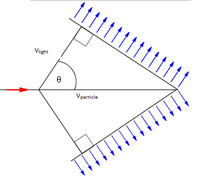Cherenkov Radiation: Difference between revisions
(→Simple) |
|||
| Line 15: | Line 15: | ||
===A Mathematical Model=== | ===A Mathematical Model=== | ||
== Simple == | == Simple == | ||
Revision as of 23:33, 2 December 2015
Cherenkov radiation, named for Soviet Scientist Pavel A. Cherenkov, is a fascinating phenomena that occurs when charges move faster than light through a particular medium. One commonly recognized example of Cherenkov radiation is in nuclear reactors which have a characteristic blue glow as a result [1].
The Main Idea
Cherenkov Radiation is analogous to a "sonic-boom of light". There are two vital parts to Cherenkov Radiation. The first is a dielectric medium and the second is a a charged particle moving faster than the phase- velocity of light. A dielectric medium is simply a medium that is an insulator but can be polarized by an external electric field. Since c, the speed of light, is commonly accepted to be the universal speed limit it seems counter-intuitive to think that any particle can move faster than light. It is important to understand, however, that light travels slower through different mediums (i.e. water, glass, etc.) The reason behind this dives into Quantum Electrodynamics (Feynman has a great book on this) but can also be pseudo-explained using classical theories.
The second important concept is the phase velocity of light. This refers to a individual portion of light and not the entire pulse. Think, for example, of a caterpillar. Each section of the caterpillar moves faster than the caterpillar moves horizontally. This phase velocity needs to be exceeded and there's no reason a charged particle can't move faster than the phase velocity. In fact, X-rays through a glass medium regularly exceed the phase-velocity of light.
Now we move into the explanation of Cherenkov radiation. When a charged particle moves through a dielectric medium it disturbs the electromagnetic field which results in electromagnetic waves radiating from the source. Think of a pebble being dropped in a pond and the 2D circle as the electromagnetic wave. Now the particle is actually moving so it is constantly interfering with the molecules around it resulting in more and more electromagentic waves. Since the particle is moving faster than the waves can propagate they start to collect in front of the particle building in intensity. Think of it like this... you drop a pebble in a lake and see the circle propagate. You time it perfectly and drop another pebble on that circle as it propagates. The two waves superimpose on one another to create an area of concentrated "circle" so to speak. Similarly a charged particle is continuously creating waves that are being superimposed on one another and move into the UV, Violet, and Blue spectrum of light. Thus we have Cherenkov radiation.
The necessary velocity of the charged particle and frequency depend on the refractive index of the medium (dictates the phase velocity) and the periodicity of the medium.
A Mathematical Model
Simple
Determining the phase velocity of light in the medium

[math]\displaystyle{ {\vec{v}_{light} = {\frac{c}{n}}} }[/math]
where c = speed of light in a vacuum and n = the refractive index of the medium
From the diagram on the right it is apparent that
[math]\displaystyle{ {cos(θ) = {\frac{\vec{v}_{light}}{\vec{v}_{particle}}}} }[/math]
A Computational Model
How do we visualize or predict using this topic. Consider embedding some vpython code here Teach hands-on with GlowScript
Examples
Be sure to show all steps in your solution and include diagrams whenever possible
Simple
Middling
Difficult
Connectedness
- How is this topic connected to something that you are interested in?
- How is it connected to your major?
- Industrial applications?
History
Put this idea in historical context. Give the reader the Who, What, When, Where, and Why.
See also
Are there related topics or categories in this wiki resource for the curious reader to explore? How does this topic fit into that context?
Further reading
Books, Articles or other print media on this topic
External links
Internet resources on this topic